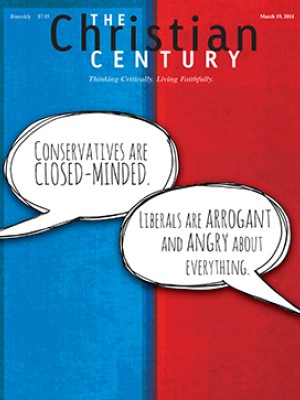A response by Theresa F. Latini: Case by case

Read Carol Howard Merritt's fictional narrative first.
At one level, the conflict is theological. Betsy’s well-developed theology of God’s work in the world and the church’s mission conflicts with the congregation’s embedded theology—its implicit beliefs, assumptions, and faith practices. The Word and Spirit of God present in the preached moment have brought this conflict to the surface so that the congregation might see and participate in Christ’s work anew.
As Betsy sees it, Christ exists in solidarity with—not separate from—this Muslim community. He suffers in and with those who are bullied, reviled, and harmed. And as Betsy sees it, the congregation, Christ’s body, does not exist except in and with those who suffer. The congregation is bound together with this suffering community by virtue of (1) their mutual coexistence with Christ, (2) their common creaturely status, and (3) their religious vocation.
Read our latest issue or browse back issues.
Christians and Muslims alike belong to God and therefore to one another. Christians and Muslims alike stand in need of God’s grace. The Spirit empowers and sends Christians to participate in and work toward God’s shalom in the world. As theologian Jack Stotts has explained, the core meaning of shalom “is that of wholeness, health, and security. Wholeness, health, and security do not mean individual tranquility in the midst of external turbulence. Shalom is not peace of mind, escape from the frustrations, and care of the surrounding environment. Rather, shalom is a particular state of social existence. It is a state of existence where the claims and needs of all are satisfied; where there is a relationship of communion between God and humans and nature, where there is fulfillment for all creation.”
Betsy’s congregants do not yet see the vulnerable Christ suffering in and with the Muslim community. Nor do they see the risen Christ overturning the tables of injustice. They do not yet know that their own spiritual and social well-being is bound up with that of the other community. They see Betsy’s words and deeds as reflections of her “politics” rather than as a response to the demands of shalom.
Perhaps Betsy unwittingly has contributed to this understanding by emphasizing the church’s ethical responsibility to the neglect of helping the congregation discern the presence of the living Christ in and with the Muslim community.
In any case, the conflict between Betsy and her congregants opens up space for renewing the congregation’s theological imagination, for addressing inadequacies in the congregation’s theology, and for encountering the same Spirit that sent Peter to commune with the supposedly unclean (Acts 10).
Just as the Spirit transformed Peter through his encounter with Cornelius, so transformation for Betsy, her congregants, and others will likely occur through encounters with members of the Muslim community. As a leader, Betsy can cultivate these encounters.
Good theology doesn’t always penetrate a situation of high anxiety. Betsy will need a mixture of prophetic admonition, priestly listening, and sagely interpretation as she leads her congregation toward participation in God’s shalom.
She might begin by listening deeply to herself—an important dimension of priestly leadership. She will bear the conflict of the community and the congregation, and conflict is an internal as well as external reality. Betsy’s capacity to remain differentiated, not governed by others’ demands, will depend on her continued spiritual and emotional renewal.
This renewal might include reminding herself as she leaves coffee hour to avoid globalizing the sentiments of Michael and Anne. Yes, they likely represent others in the church and community, but there’s no indication they represent all or even the majority.
Along with careful listening comes wise interpreting. Embedded within Anne’s criticism are longings for justice, equality, and wholeness for women; for a thriving community; and for some peace and rest in the midst of turmoil. Surely these are points where Betsy could begin to connect with Anne and others.
As for Michael, his understanding of Christian faith reflects both the differentiation of spheres of life characteristic of modernity and the highly polarized and polarizing political discourse so widespread in the United States. Michael, Anne, and others in the community likely are motivated by powerful images of Muslims as the enemy—inherently dangerous. Transforming these images is most likely to occur in personal and small group settings.
The challenge for Betsy is to resist the demonization of Muslims without slipping into despondency or disdain for those engaging in these behaviors. Becoming what we hate is an ever-present danger.
Soaring levels of discrimination and hate crimes against Muslims in the United States are well documented, making this story about Betsy and her congregants urgently applicable. Given the intertwined layers of conflict—personal, congregational, communal, global—played out on the backs of Muslims, a Christian leader will need to listen to God, self, and others; interpret the work of God’s Spirit as well as the needs of humanity; and teach in a variety of settings, including worship, education classes, council meetings, and informal conversations. Trusting that the Spirit can use this conflict to transform violence into shalom will help sustain this labor of love.





